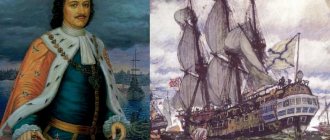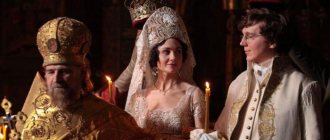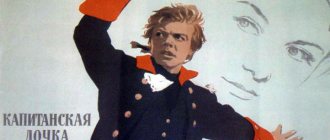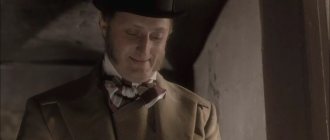Essay on the topic: The image of Peter the Great in A. N. Tolstoy’s novel “Peter the Great”
Composition. The image of Peter the Great in A. N. Tolstoy’s novel “Peter the Great”
A. N. Tolstoy approached the novel “Peter the Great” gradually and from afar. First, back in the 20s, he wrote the stories “The First Terrorists”, “Obsession”, “The Day of Peter”, and then “The Tale of Troubled Times” and the play “On the Rack”. And only at the end of all this does he begin to work on the novel “Peter the Great”. The writer himself noted: “Working on “Peter” for me, first of all, is an entry into history through modernity... The result is that history began to reveal untouched riches to me.” In his novel, A. Tolstoy created a complete picture of Russia - from the imperial palace to the wretched peasant hut; painted the life of the country against a broad European background. But history does not act as a background for the writer. The authentic events of Russian history in its movement and struggle form the basis of the plot in the novel. And this is one of the author’s great achievements. The central person to whom the threads of the historical movement of the era converge in the novel, the plot center of the entire narrative in A. Tolstoy is Peter I. The writer sees the strength of Peter, his merit and significance in the fact that he understood the objective laws and requirements of his era, subordinated his activity. The transformation of Russia, the implementation of broad political plans - the work of Peter's whole life. In A. Tolstoy’s portrayal, Peter is, first of all, a major statesman and national figure. He is the son of his century, an ardent patriot of Russia and at the same time a multifaceted personality, endowed with all the main features of the transitional era. The composition of the work, along with the movement of “big history,” is based on the development of Peter’s character, his maturation. The writer shows the gradual transformation of a naughty, persistent, hot-tempered, restive boy, a “wolf cub”, in the words of Princess Sophia, an angular teenager, a long, restless “young man” into an unyielding ruler, a brilliant reformer, a formidable military leader, a wise diplomat, a great statesman and political figure. A. Tolstoy endowed his hero with human feelings and passions, created a living image of Peter with his insatiable love of life, stormy temperament, indomitable daring will, “wild, greedy, alarmed mind,” acute curiosity, tough, tough disposition. Peter's youth and youth were full of sharp, dramatic clashes and intense struggles for power. Early on, from childhood, an irreconcilable hatred began to speak in him for the conservative, stuffy antiquity, for the immobile way of old Moscow, for the slow and tedious boredom of magnificent palace ceremonies, for the arrogant and arrogant boyars, who could only doze lazily on their benches. From the personal feeling of this hatred, his principles grew over time, giving impetus to his passionate activity, turning into an inexhaustible source of energy, encouraging him to destroy the old, objectionable, to search for and coolly implement the new. Peter's greedy and inquisitive mind, his characteristic practical acumen, and foresight give him the opportunity to grasp and feel the tasks facing the Russian state before many others. With all the strength of his character and temperament, Peter sets out to break and eradicate backward orders, to create an army and navy. He shaves the boyars’ beards, dresses the boyars’ daughters in dresses “with slaps” and teaches them “polites,” and sends their sons abroad to study various sciences and at the same time wages a persistent struggle for Russia’s access to the seas, promotes the development of Russian trade with the West, builds factories, founds the new city of St. Petersburg. Peter's thoughts are constantly turned to his homeland, to his country. Peter experiences acute resentment and pain for the poverty and scarcity that he sees in his Rus': “What kind of Russia is this, a cursed country, when will you move?” He throws angry words at the boyars: “In all Christian countries - and there are some that are not even worth our district - trade is growing fat, people are getting richer, everyone is looking for their own profit... Only we alone are sleeping soundly. Soon the Russian land will be called a desert.” With bitterness he exclaims: “The devil brought me to be born a king in such a country!” How modern all these words sound today! Peter becomes an autocratic ruler and, overcoming the resistance of the boyars, decisively enters into the struggle with Old Russia for New Rus'. The first book of the novel ends with meaningful words: “The old is hidden in dark corners. Byzantine Rus' was ending. In the March wind, the ghosts of merchant ships could be seen beyond the Baltic coasts.” A. Tolstoy’s Peter is a very down-to-earth man, a son of his era. Tolstoy often depicts his Peter with a wheelbarrow at a construction site, with an ax at a shipyard or with a sledgehammer in a forge. He is simple, hardworking, active, and does not shy away from people of “vile rank.” Most often, Peter is shown not in royal clothes, but either in a military caftan, or in a “stained canvas shirt with sleeves rolled up to the elbows,” or in a sailor jacket. Tolstoy emphasizes both Peter’s “peasant” manners and his passion for strong words. While visiting the German Electors, ladies who were both well-mannered and educated, he “wipe his hands on the tablecloth, slurped loudly, used sailor words, winked with his round eye and, for emphasis, tried more than once to nudge Sophia-Charlotte with his elbow.” Peter's characteristic mockery and sly humor also manifests itself. The author depicts his hero-king sometimes in far from heroic moments: in a state of panic fear and confusion or uncontrollable anger, in moments of his inner confusion, depression and grief, in funny family quarrels with his wife, in love scenes with Anna Mons. But all this, however, does not obscure the main and most important thing in Peter - his state activity. The writer strives to show Peter in the context of his affairs, decisions made, in the thick of events. In the third volume of the novel, we see Peter already fully formed: both as a person who has become restrained and reasonable, and as a statesman who is deeply aware of the enormous responsibility for the fate of Russia. And it is no coincidence that the author now calls him not just Peter, but Peter Alekseevich. However, A. Tolstoy nowhere strives to present Peter as an ideal figure, to make him more humane and humane than he actually was. While creating the image of Peter, the writer at the same time did not forget that he was an autocrat, a serf owner. Peter's reforms often had the character of a sharp, decisive and brutal break. In the novel, Peter asks himself an impatient question: “With what forces to push people aside, to open their eyes?.. Give some kind of terrible decree? Rehang? Should I flog you?” He forcibly cuts off the beards of the boyars, participates in the cruel torture of his enemies, uses a “club” to drive noblemen into science, and arranges the desecration of princely and old boyar families at Christmastide. It is under him, the serf-owner Tsar, that the people's, peasant Rus' is groaning from unbearable exactions and quitrents. It is under him that the poor are flogged to death with batogs, serfs are driven into shipyards, soldiers are taught with sticks, free people are deceived into entering cloth, linen, silk factories and paper mills erected by order of the tsar. “Peter the Great” is a work about a great era with its statesmen and masses, with its contradictions and conflicts, with difficulties and victories. The heroes of the novel are put forward by history, but at the same time they themselves are its participants and creators. The main idea of A. Tolstoy’s novel is the idea of the power of the great Russian people. This makes the book a noticeable phenomenon of national consciousness.
The image of Peter I in the novel by A.N. Tolstoy "Peter I"
The image of Peter I in the novel by A.N. Tolstoy "Peter I"
In the novel “Peter I” A. N. Tolstoy depicted time, events, people, their way of life and customs with historical truthfulness. “To understand the secret of the Russian people, its greatness,” the author wrote, “you need to know its past well and deeply: our history, its fundamental nodes, the tragic and creative eras in which the Russian character was born.”
A. N. Tolstoy widely covered the most important events of the Peter I era, showed the role in them of the most diverse segments of the population and the enormous historical significance of the figure of Peter I.
On the pages of the novel, Tsarevich Peter appears in the scene of the Streltsy rebellion, when his mother, Natalya Kirillovna, carries the boy out onto the porch: “Chubby and blunt-nosed, he craned his neck. The eyes are round, like those of a mouse...” He saw the bloody massacre, the exorbitant cruelty of the archers, incited by Khovansky and Vasily Golitsyn. These events left an indelible mark on the prince’s soul and caused a nervous shock.
Peter grew up very active, excitable, impressionable; it was impossible to contain him in the hothouse atmosphere of the palace, where his two brothers withered away.
There was a struggle for power, and Peter shocked the boyars with his frivolous behavior, games inappropriate for a tsar, scratches, bruises and pimples on his arms.
Peter was drawn to the German settlement; he is very interested in life on Kukui, where he is surprised at everything: “Why is this? What is this for? How does this work?” He will remain like this for the rest of his life, thanks to his lively curiosity he will constantly learn, let everything pass through himself, not be afraid of any work, no difficulties. He must reach everything himself; to carry out reforms, he needs independence of mind, the absence of authorities.
A. N. Tolstoy shows the extraordinary endurance of Peter, who could go for days without sleep or food, forcing everyone in the amusing army to unconditionally accept his rules of the game, which eventually turned into a serious study of military science. The comrades in these games are boys from the common people, smart, loyal and brave - the core of the future guard.
In one of the chambers of the Preobrazhensky Palace, a ship workshop was organized, where, under the leadership of the Germans, they built models of galleys and ships, and studied arithmetic and geometry. Boris Golitsyn advised Peter to build a shipyard on Lake Pereyaslavl and sent him the necessary literature, and Natalya Kirillovna said: “You gave birth to a good son, he will turn out to be smarter than everyone else, give him time. His eye is awake..."
Peter, who loved the German Anna Mons (later erased from his heart for betrayal), was married to A. Lopukhina, a young, stupid and primitive girl who wanted her husband to sit near her skirt. But Peter was busy with work and worries from morning to evening - amusing ships were being built on Lake Pereyaslavl.
Having learned from Uncle Lev Kirillovich about Sophia's conspiracy, that the royal power was hanging by a thread, Peter remembers the horrors of his childhood, the execution of the Naryshkin supporters, and he has a seizure. He rides into Trinity; Sophia, having learned about this, says: “It’s free for him to run wild.” Counting on the troops, she was mistaken: the archers went to Peter, despite Sophia’s threats. “Like a dream from memory - power was leaving, life was leaving” from Sophia.
The situation in the country forced Peter to be cruel and merciless (often beyond measure); terrible theft, desolation, backwardness caused him terrible anger.
Peter grew very mature after the defeat at Azov; failure hardened him, he became stubborn, angry, businesslike. He sets his sights on a new campaign; For this purpose, it strengthens its combat power: it builds a fleet in Voronezh. And two years later, victory was not long in coming.
Peter's struggle with the boyars was cruel and irreconcilable; he broke the structure of the old boyar duma; now admirals, engineers, generals, foreigners sat in it - all of them were like-minded people of the young tsar.
A. N. Tolstoy describes in detail the profound changes in Peter’s consciousness after his trip abroad. There was a lot there that was extraordinary and marvelous for the Russian eye. Peter remembered sleepy, poor and clumsy Russia, he does not yet know, “with what forces to push people aside, to open their eyes... The devil brought me to be born a king in such a country!” All these thoughts arouse in him furious anger towards his own people and envy towards foreigners. The first impulse is to outweigh, to flog. “But who, who? The enemy is invisible, incomprehensible, the enemy is everywhere, the enemy is within himself..."
In Holland, Peter works at a shipyard as a sailor, is not afraid of any work, and studies shipbuilding. Peter's personality is actively being formed, his active, state mind is revealed, everything in him is subordinated to the main goal: to turn his country on the path leading from vegetation and isolation to progress, to the introduction of the Russian state into the circle of advanced states as a great power. He sets his sights on a war with a strong enemy - Sweden, in order to have access to the Baltic Sea. Realizing that for this he needs to be well equipped and armed, he decides to build factories in the Urals.
The defeat at Narva did not break Peter, but forced him to act: “... we haven’t learned to fight yet... for a cannon to fire here, it must be loaded in Moscow.” He begins careful preparations and three years later, having marched with a new army, with new cannons against the Swedes, he wins, standing firmly on the shores of the Baltic Sea.
Speaking as a realist writer, A. N. Tolstoy truthfully describes the foundation of the new capital of Russia - the city of St. Petersburg. Peasants work in terrible conditions: in swamps, half-starved, ragged, sick; the city is built on human bones.
A. N. Tolstoy looks at Peter not only as a major historical figure who controlled thousands of people, but also conveys the tsar’s ability to maintain friendship and respect for Lefort, to listen to his advice. Lefort’s death was a huge loss for Peter: “There will be no other friend like him... Joy - together and worries - together.”
A. N. Tolstoy widely shows the abundance of national talents, which Peter noticed and sent to study abroad, since he understood that without young scientists it was impossible to make changes in the country. Peter valued people not for ranks and titles, but for talent, skills, dexterity and hard work, so in his circle there were many people from the people: this was Aleksashka Menshikov, and the Brovkin family, and Fyodor Sklyaev, and Kuzma Zhemov, and the Vorobyov brothers, and many others.
There were nobles and boyars who understood and supported the tsar: Prince Caesar Romodanovsky, the skilled commander Sheremetyev, diplomat Pyotr Tolstoy, Admiral Golovin, and clerk Venus.
The more grandiose Peter's plans are, the tougher his character becomes; he is unforgiving towards those who hinder his progress and slow down the implementation of his ideas.
The merchants played a very important role in the tsar’s reforms: “God tied us with one rope, Peter Alekseevich, - where you go, we go,” says Ivan Brovkin to Peter on behalf of the merchants.
Despite the scale of the transformation of Peter I, not only did they not improve the lot of the people, but, on the contrary, led to increased exploitation and increased extortions from poor peasants. They were driven thousands of miles away to build ships and cities, separating them from their families, to mine iron, and were marked to death as soldiers. All this is also covered in the novel.
A. N. Tolstoy created a monumental image of Peter I, but this is not the ideal figure of a “crown bearer.” He depicted the most complex interweaving of rough and gentle, kind and evil, humane and cruel. But, of course, Peter I was a man of genius in terms of his potential and the scale of the transformations carried out in Russia.






